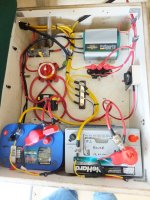Thanks for the info. I'll add some notes/questions:
thataway":3rcwate9 said:
There is always some voltage drop--maybe not enough to be significant.
Understood. I figured it would be a given that I would size the cable to get the down to an acceptable level.
thataway":3rcwate9 said:
When you put batteries into a storage area, this not only decreased the amount of storage, but you have to encase the battery, switches etc--and if you store things above that there are a number of precautions which may have to be taken.
True. I have AGM batteries, so from what I can tell, it is okay to have them in the cabin. I would probably build "false floor" above them (that I could pull out at will) so the remaining storage would be useful. Right now it is one very deep "cavern."
thataway":3rcwate9 said:
Storage area is precious in a C Dory 22. How much difference in the list etc will moving a 58 # (or less) battery.
Well, part of this is that I would like to add a second house battery and solar panel(s) plus controller. So that means more like #140 pounds of batteries. That's about like a person sitting there, and with a person sitting the boat runs better. Also, access where I have the one battery now is difficult, and there is no room at all for a second house battery. Maybe I should have explained that a bit more.
thataway":3rcwate9 said:
Hence Consider you may also put in some substantial cable, which will be distributed all along that side, and increasing the total weight of the boat.
I initially wrote this idea off for that very reason, but then when I did a rough calculation, I came up with #2 cable (this may not be big enough, it was only a napkin sketch), and it really doesn't add that much weight (proportionately). So I put the idea back on the table. Especially if adding a second battery.
thataway":3rcwate9 said:
If you have the battery only 3 feet from the helm, does it make sense, to run cables 12 feet back (the large cable) and then the 16 feet up to the console, or do you run another circuit to the helm directly?
Good question. I'm really not sure. There are a lot of components back in the lazarette, and some of them would have to have long cables added because they come from astern (start battery/switch/trim tab components). I'm all for tackling the big sucky project if the outcome is good (I only have to do it once, I always figure), but if it's a horse apiece... well, they are already in place, that lazarette is sort of "fake" anyway (no bottom etc.), and it's a handy place to "one stop shop" for the switch etc. My starting battery would stay there anyway, so I'd not be making it into a propane locker or something else useful. The other thing is that even though it's further, it seems easier to run wires aft from the helm (where there are easy/hidden channels) rather than go "across the stream" to the port side.
So my thought was, if I could properly install two AGM house batteries (around 140#) under a sub-floor in the port seat locker, that would get the weight right where I need it, and my solar controller and cabling could just go right there from the roof. The only "connection" needed (IF this can be done correctly, which is why I'm asking) would be my two honking cables (still a lot lighter than the batteries), and then everything else could stay at "command central" in the lazarette.
Or maybe it doesn't work that way, and I can't have the batteries situated remotely, no matter the cable size? That's what I'm not sure about. I thought maybe that as long as I negated excessive voltage drop with heavy cables, and proper fuses protected that cable run, then everything would "think" it was right by the batteries, and not 14' away (?)
Sunbeam

